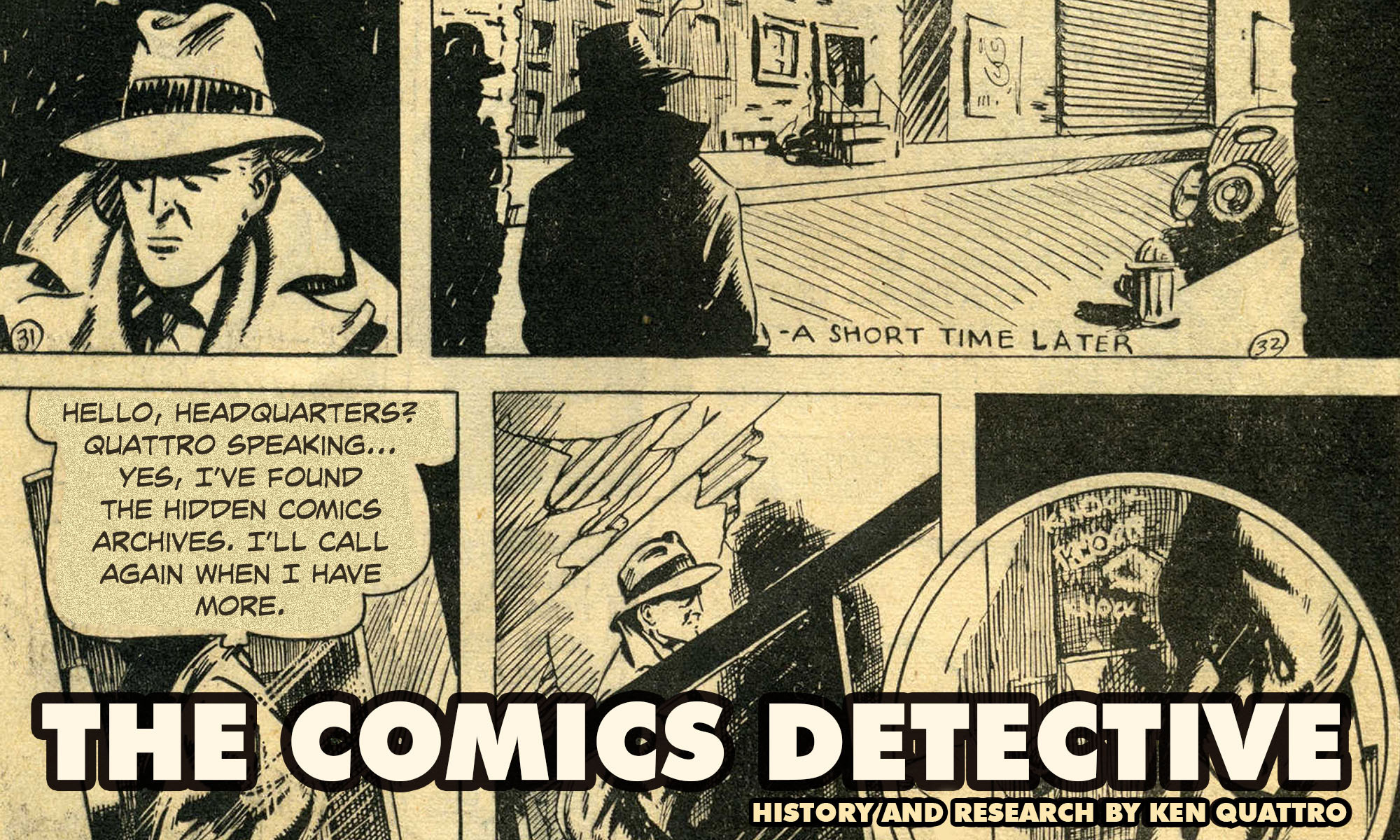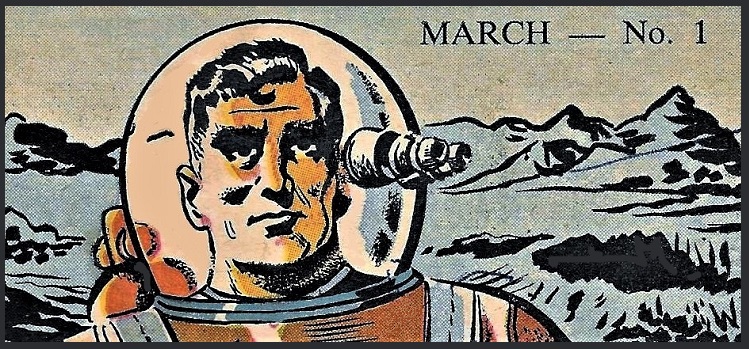

Border Crossing: The Story of Canada’s Export Publishing
©2020 Ken Quattro
[Special thanks to Wayne Smith and Stephen Lipson]
Canada has always had a complicated relationship with the United States. Inexorably linked to its neighbor to the south by geography, language and cultural commonalities, Canada has borne the linkage with both gratitude and resentment.
Stronger economically, militarily and possessing a far larger population, the US understandably casts a long shadow over Canadian affairs. While a special friendship has evolved between the two nations, Canada still has its own concerns that sometimes run counter to the mutual interests it shares with the US.
In December 1940, Canada passed the War Exchange Conservation Act (WECA), which restricted the importation of non-essential goods, comic books included.
“The clause in the budget which banned import of ‘pulp’ fiction magazines and comics from the United States has been followed by a ruling prohibiting also the import of materials from which these may be printed, such as mats, stereos, etc. Accordingly, if these magazines are to be distributed in Canada, it will be necessary that they be produced entirely here.” [“Public Savings Turned Into War Channels,” NATIONAL POST, Dec. 14, 1940.]
This directly led to the birth of the homegrown Canadian comic book industry.
Over the next four years, in the absence of American competition, Canadian comic book publishers flourished. One of the first out of the gate was Cyril Vaughn Bell, a Toronto printer and sign painter.
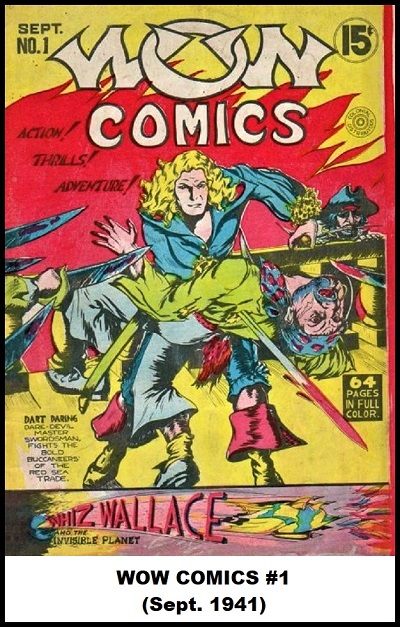
WOW COMICS #1
(Sept. 1941)
“Bell happened to have a small color press in his sign-painting shop which was used occasionally for printing billboards and banners for used-car lots.”
“When one of his sign-painters, Edmund Legault, revealed that his secret ambition was to become a newspaper cartoonist, and that in his spare time he’d created a comic strip called Dart Daring and drawn several months of episodes, Bell decided to put his idle press to work and ran off fifty-two thousand copies of a Dart Daring comic book.” [Ross, Alexander, “The Wild World of Wartime Comic Books,” MACLEAN’S, Sept. 19, 1964.]
The comic featuring the debut of “Dart Daring” was WOW COMICS #1 (Sept. 1941), which, like its American counterparts, was 64 pages long and in four colors. However, Bell’s press was not up to the task of printing comic books, resulting in pale, washed out, off-register colors. So, after eight issues of trying less and less color in his books, Bell finally decided to print just the cover in color and the interiors in black-and-white. The rest of the fledgling Canadian comic book industry had already taken that cost saving path and so was born the legendary “Canadian Whites,” the popular name give to the Canadian comics published during the WECA era.
Out of a necessity created by the government edict, the Canadian comic book industry produced its own crop of creators to produce their comics. One of the stalwarts of Cyril Bell’s Bell Features and Publishing Company was Theodore “Tedd” Steele.
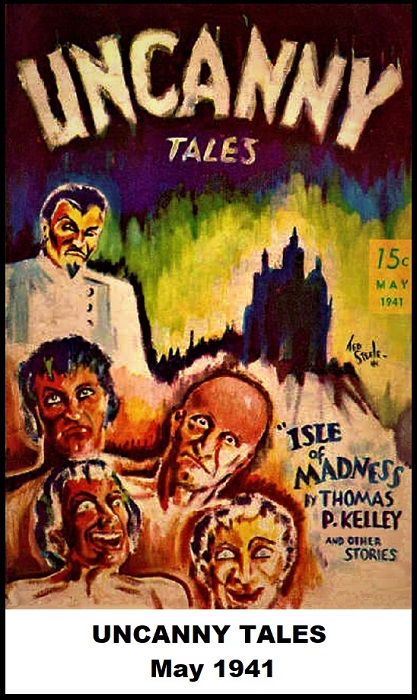
UNCANNY TALES
(May 1941)
Steele was a young Torontonian artist, born in 1922, who came from a large, close-knit family that would figure significantly in his career. Still in his teens when he began working as a professional, Steele, likely adopted the unique spelling of his first name to differentiate himself from the leader of the then-popular Ted Steele and the Novatones orchestra of radio fame.
In early 1941, Steele produced the cover for the May issue of UNCANNY TALES, a science fiction pulp digest, published by the newly formed Adam Publishing Company of Toronto. Like comics, American pulps had been banned from Canada and Adam Publishing took advantage of the opening.
At about the same time, it appears he also supplied the cover and interior artwork for a hastily put-together effort entitled ROCKET (titled CANADIAN ROCKET on its cover), dated April 1941. Unlike most newsstand comics, ROCKET’s cover was printed on newsprint. This comic is notable as it contains the Steele creation, “Wolf Savage,” who is credited with being Canada’s first costumed superhero. A month later, his artwork also appeared in VICTORY #1 (May 1941), a one-shot comic from Victory Publishing Co. that featured “Rock Thunder,” another Steele superhero. By 1942, Steele was working regularly for Bell Features and over the span of the WECA era, he became one of its most prolific creators.
Despite the steady work he was getting from Bell Features, Steele apparently desired more. While he was still producing material for comic books, he joined in on a publishing venture. A venture with origins that began a decade before.
Circa 1935, the Steeles and the Schrags lived in Toronto’s High Park neighborhood, at 108 and 110 Gothic Avenue, respectively. The house was a semi-detached duplex, so essentially they lived under the same roof with only a wall in between. It was tight quarters as Arthur and Etta Steele had eight children while Roland and Margaret Schrag had five. People get to know one another quite well in such living arrangements.
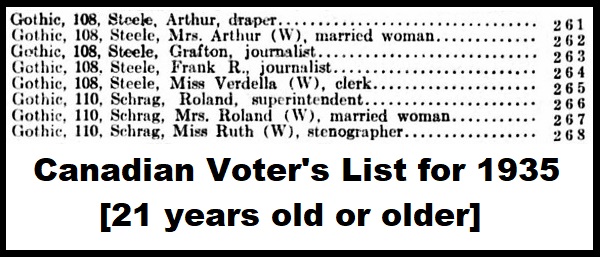
Canadian Voter’s List for 1935
[21 years old or older]
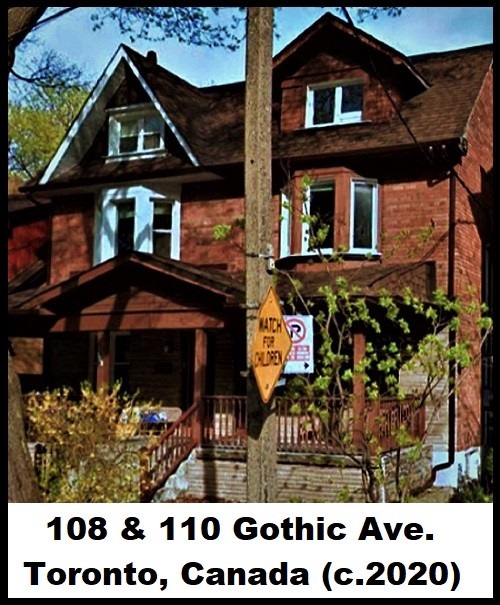
108 & 110 Gothic Ave., Toronto, Canada (c. 2020)
Frank Steele, born in 1909, was the third oldest child of Arthur and Etta and eight years older than the Schrag’s son, Stanley, who was born in 1917. Harry Steele was a year younger than Stanley. Yet, despite their age differences, these three would form the nucleus of the future publishing venture. It was not a direct path, though, as Stanley Schrag had some detours along the way.
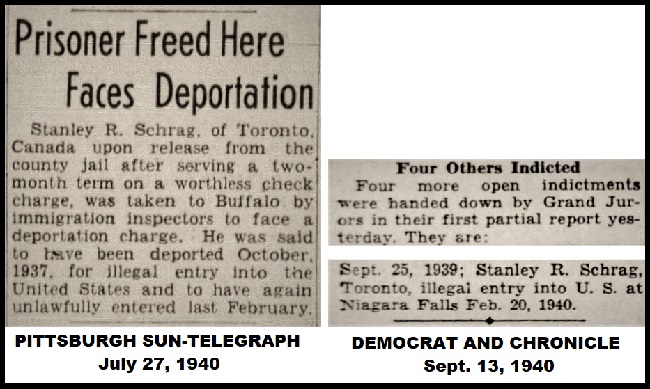
PITTSBURGH SUN-TELEGRAPH, July 27, 1940;
DEMOCRAT AND CHRONICLE, Sept. 13, 1940
His first came in October 1937, when he was sent back to Canada for entering the US illegally. Parenthetically, Harry Steele also came to the US in 1937, but he did so legally to work in Buffalo, New York. Schrag tried once again in February 1940, and was caught by immigration authorities. The US Census of 1940 counted him as a resident of the Cook County Jail in Chicago on April 1, 1940. Then, in July 1940, he was taken to Buffalo, New York after serving two months in a Pittsburgh prison for bouncing a check. In September, 1940, he was indicted for entering the US illegally and once again, deported.

TORONTO GLOBE AND MAIL
Nov. 9, 1940
Yet, in spite of all his legal troubles, Schrag was able to find a way to finance a foray into publishing just a few years later. His pathway may have come through his friendship with Frank Steele. Steele had made his own attempt at publishing, but like Schrag, he ran into legal trouble.
“The first move in a campaign against obscene or immoral publications was taken yesterday by Attorney-General Gordon Conant at Osgoode Hall, when writs were issued and notices of motion and statements of claim filed in connection with five publications.”
“‘There is no place in this Province for obscene or immoral publications,’ said the Attorney-General, in a statement issued from Queen’s Park. ‘The law will be strictly and aggressively enforced, and those responsible for such publications will be required to answer in the courts.'”
“Defendants are Frank Steele, 78 Wellington Street West, Sex Life…” [“Ask Injunction on 5 Magazines,” TORONTO GLOBE AND MAIL, Nov. 9, 1940.]
As in the United States, governmental entities in Canada were cracking down on “obscene” publications. Steele, et. al., were in the company of such American publishers as Harry Donenfeld, who also had his run-ins with the law over such material, but had managed to survive, go on to publish comic books and attain respectability behind the capes of Superman and Batman.
The case against Steele and the others wound its way through the courts, as the attempts by Attorney-General Conant to ban the lewd magazines outright were thwarted by judges who ruled that such a ban was not allowed under existing law. Conant appealed and rather than continue a long and expense court battle, the five defendants agreed to cease publication of their sex magazines, including Steele.
However, the agreement did not preclude Steele from publishing other magazine formats. It is perhaps significant that the settlement between the government and the five publishers came on January 13, 1941, and soon after, the first artwork by Tedd Steele for Adam Publishing–in CANADIAN ROCKET–appeared with an April 1941 cover date. And like Frank Steele’s SEX LIFE digest, Adam Publishing was located at 78 Wellington Street West, in Toronto.
The advent of WWII had led Canada, like the United States, into instituting a series of wartime limitations on necessary materials such as steel, wool, and paper. While Canada itself was a huge producer of paper, in fact, it was America’s largest supplier, it was forced to restrict the consumption of newsprint by its own citizens to meet the demands of its American allies.
“Many phases of business and everyday life in Canada are affected by a series of far-reaching orders and changes, most of them concerning the Dominion’s war economy, which come into effect this week.”
“Here are the major orders and changes…Newsprint quotas restricting production go into effect, starting with November output.” [“All Citizens are Affected by New Rules,” TORONTO GLOBE AND MAIL, Feb. 11, 1942.]
This was serious business. The Canadian government created a department solely dedicated to administrating the supply of newsprint. It was announced that the paper could be “manufactured, sold or shipped only under permit as from Nov. 1.”
“The order is designed to bring about the proper allocation so that the demands of the Canadian, U.S. and overseas markets can be met in an orderly way.” [“Put Newsprint Under Control,” NATIONAL POST, Nov. 7, 1942.]
These wartime controls naturally hamstrung publishers. In the United States, the War Production Administration (WPA) set strict quotas for each publisher, fixing their allotments to their 1941 paper usage. New publishers were assigned much smaller quotas in comparison. Crafty publishers would purchase the paper quotas assigned to other publishers and use them for their own publications. Canada worked in close cooperation with the US and the WPB, as it was supplying 75 to 80 percent of all the newsprint used in the US.
Presumably similar quotas existed in Canada, leading Schrag to purchase an existing newspaper publisher and in the process, also acquire its newsprint allotment. That may explain why Stanley Schrag (with the probable help of Frank Steele) ended up owning a company named Associated Weekly Newspapers.
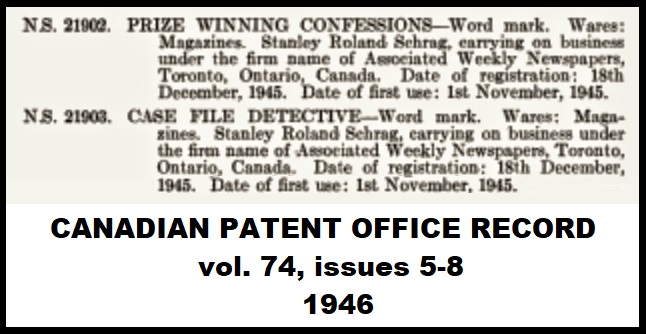
CANADIAN PATENT OFFICE RECORD
vol. 74, issues 5-8
1946
Appearing on newsstands in December 1945, the first Associated Weekly Newspapers lineup of magazines included PRIZE WINNING CONFESSIONS, CASE-FILE DETECTIVE and COMPLETE DETECTIVE STORIES. The latter title was used previously on a one-shot detective pulp published in June 1941 by Victory Publishing Company. The same company that published the VICTORY #1 comic book. And like that comic, this issue of COMPLETE DETECTIVE STORIES featured a Tedd Steele cover.
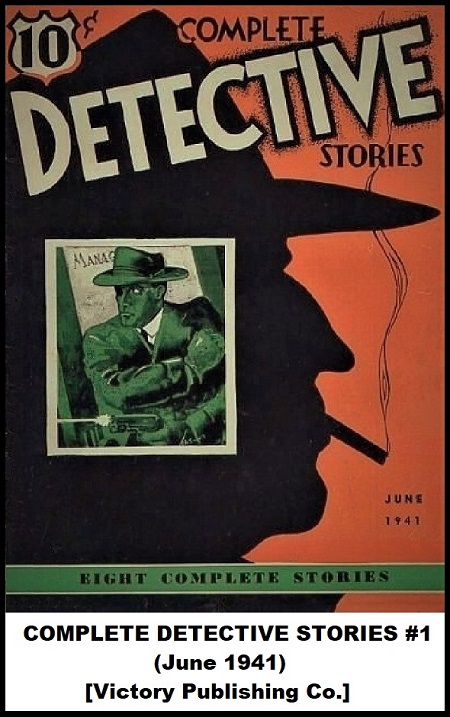
COMPLETE DETECTIVE STORIES #1
(June 1941)
[Victory Publishing Co.]
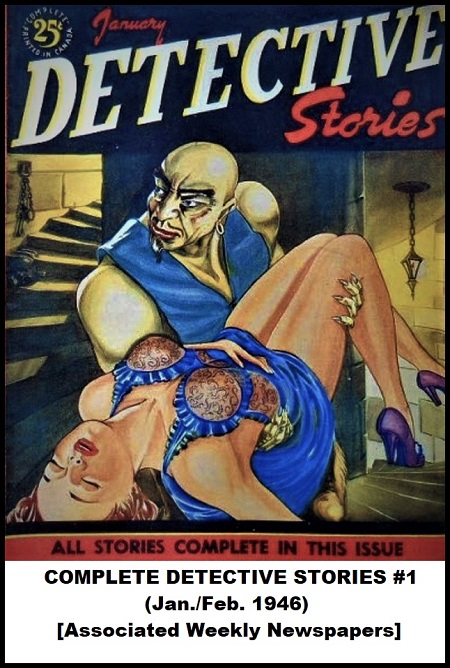
COMPLETE DETECTIVE STORIES #1
(Jan./Feb. 1946)
[Associated Weekly Newspapers]
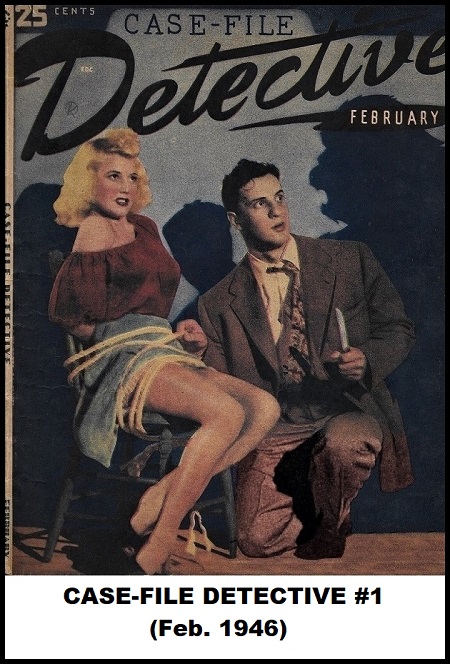
CASE-FILE DETECTIVE #1
(Feb. 1946)
The Owner’s Statement found in CASE-FILE DETECTIVE #1 (Feb. 1946) revealed the information that Stanley R. Schrag was sole proprietor and business manager of Associated Weekly Newspapers, Frank R. Steele was the editor, and Martin Kastner was named as its managing editor.
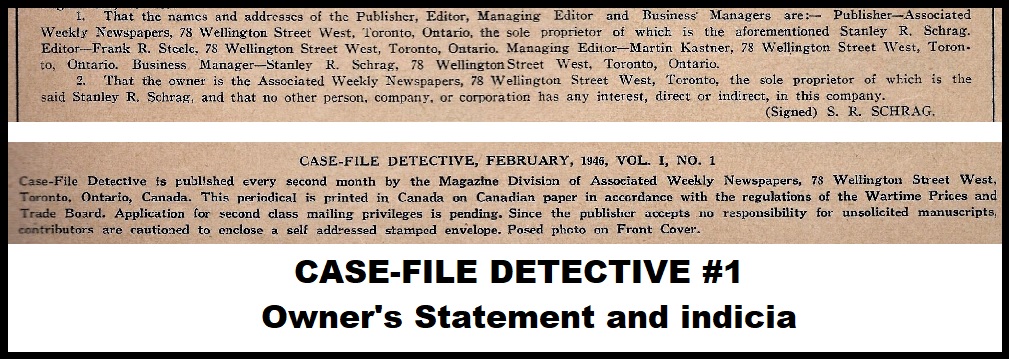
CASE-FILE DETECTIVE
Owner’s Statement and indicia
Martin (née Meyer) Kastner was born in Vienna, Austria in 1910 and came to Canada in 1927. Not long after, he married his first cousin, Rose, and got a job as a linotype operator.
“Martin Kastner became a printer after coming to Canada and ‘through sheer ignorance’–he didn’t realize that a press he’d acquired was only supposed to print newspapers and somehow he managed to adapt it for books…” [“Turcotte, Eileen, “The Kastners: One Man’s (unplanned) Family,” OTTAWA JOURNAL, March 13, 1971.]
Frank Steele brought with him experience as a journalist. In time, other members of the Steele family joined in. Harry was a printer, and of course, Ted was both an artist and a writer.
It is probably worth noting that the address for Associated Weekly Newspapers of 78 Wellington St. West in Toronto, was the same address where Adam Publishing Company was located when Tedd Steele worked for that company back in 1941.
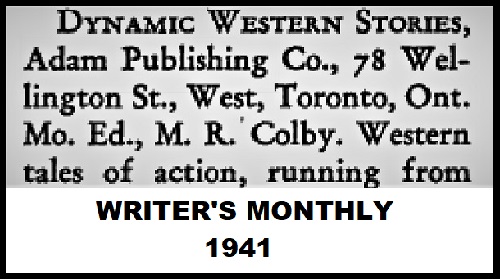
WRITER’S MONTHLY
(1941)
The timing of Schrag’s entry into the publishing business is curious, since the Canadian government announced it was relaxing the ban on American publications into the country in the summer of 1944.
“Finance Minister [James] Ilsley in his budget speech swept aside a long list of prohibitions on United States imports that has been in effect since 1940…”
“The prohibition, now lifted, applied to…certain magazines and comics…”
“[Ilsley’s] action Monday night removed the ban before the end of the war, as a gesture of commercial amity with the United States.” [“Tariff Gate Opens for Many Things,” REGINA LEADER-POST, June 27, 1944.]
Essentially, by allowing American periodicals, including comic books, to once again flow freely into the country, it curtailed the production of original comic book material by Canadian publishers. Over the next couple of years, the “Canadian Whites” were replaced by the more popular and colorful US comics. Some Canadian comic publishers couldn’t compete and went out of business. Schrag’s decision to start-up a new publishing venture in this climate was a bold move.
Apparently, though, Schrag was undaunted. He plunged ahead, but instead of concentrating on the true crime magazines as they had in the beginning, his company went in another direction. In November 1946, Schrag adopted the name Export Publishing Enterprises, Ltd., which primarily published paperback books.
Actually, the move to paperback publishing started while the company was still called Associated Weekly Newspapers. In 1946, the publisher produced several paperbacks for sale in the United Kingdom for T.A. & E. Pemberton of Manchester, England.
British publishers were still subject to the Paper Control Order instituted during WWII, which limited their consumption of newsprint to 25% of their pre-war usage. That severely impacted the domestic production of books, magazines and newspapers. Consequently, Pemberton, a distributor, looked elsewhere for reading material to fill their newsstands, which led them to contact the Canadian publisher.
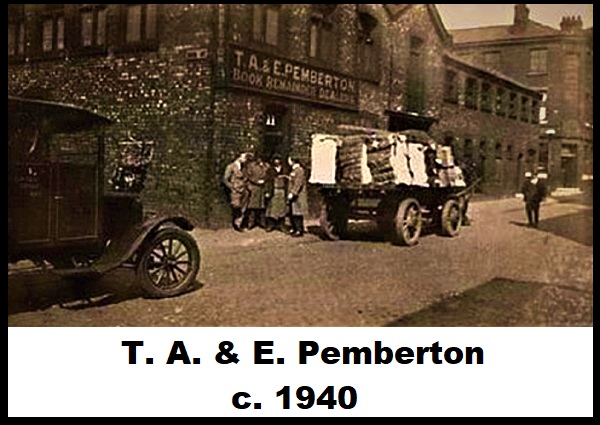
T.A. & E. Pemberton
circa 1940
One known paperback produced by Associated Weekly Newspapers was Thomas P. Kelley’s, TAPESTRY TRIANGLE, a mystery featuring an immortal Chinese adventurer. That same year, now under the name of Export Publishing, they published CIMARRON BEND, a Western, and another Kelley novel, I FOUND CLEOPATRA. This novel also appeared in the July 1941 issue of Adam Publishing’s UNCANNY TALES. one more thread of connection between Export Publishing and that earlier publisher.
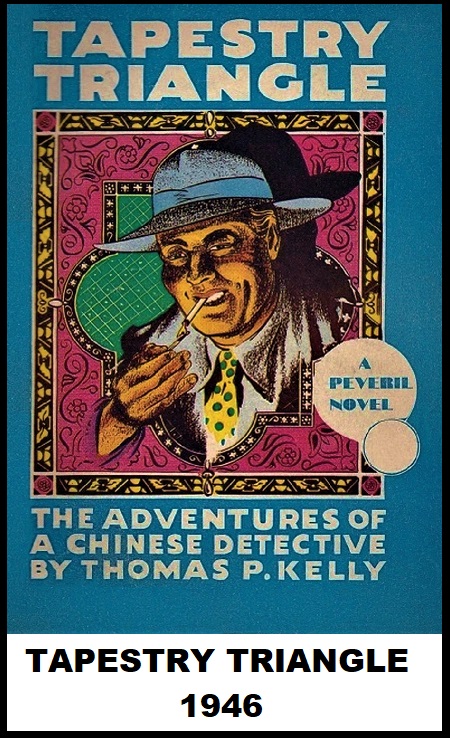
TAPESTRY TRIANGLE
1946
Actually, Export Publishing was just one of the businesses Schrag was running out of his new address at 3079 Dundas Street W. in Toronto.
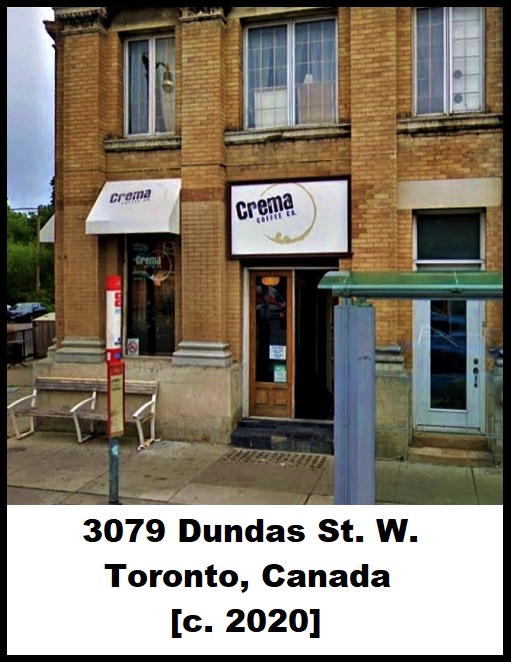
3079 Dundas St. W., Toronto, Canada
He also had a side business selling books, “best sellers,” by way of his Associated Book Division. And he even started a mail order house dubbed Associated Manufacturers’ Agencies (“Agency” in some ads) devoted to selling “such items as farmers’ supplies, furniture, clothing, household medicines and sundry items” in “rural areas in Canada and the Empire.” He ran ads in both Canadian and American newspapers soliciting saleable items. The success of this business is unknown.
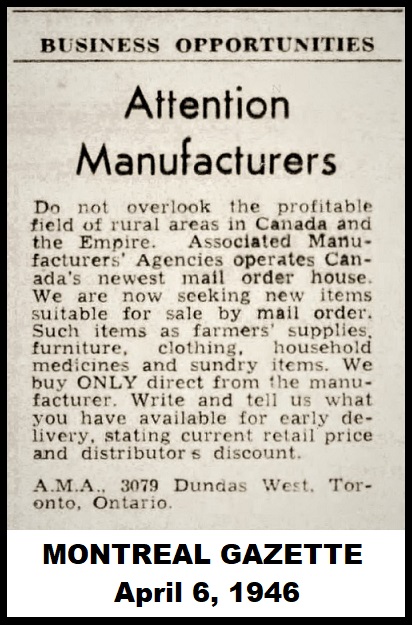
MONTREAL GAZETTE
April 6, 1946
Schrag was apparently aware that any expansion of his publishing ventures would put him in direct competition with the flood of American publications flowing across the border. With an eye toward stemming that tide, he formed an organization with other similarly impacted companies to made their concerns known.
“While members of the Periodical Press Association, embracing leading magazines, business papers and farm papers of Canada, dissociated themselves from the venture, a new publishers’ organization prepared this week to seek tariff protection for Canadian periodicals.”
“Sponsor of the movement is S. R. Schrag, proprietor of Associated Weekly Newspapers. To gain support for this move, he has formed an organization known as the Canadian Independent Publishers’ Association [CIPA] and has circulated a number of major Canadian periodicals, soliciting membership. Affiliations are ‘open’ to printing plants, engraving, ink manufacturers, advertising agencies, publicists and publishers.”
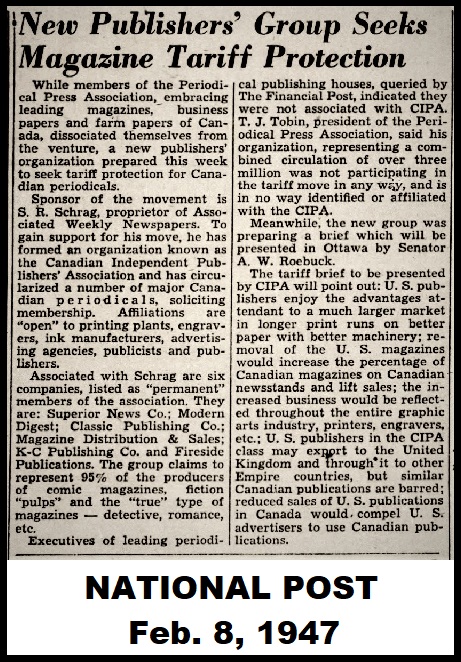
NATIONAL POST
Feb. 8, 1947
“Associated with Schrag are six companies, listed as ‘permanent’ members of the association. They are: Superior News Co.’ Modern Digest; Classic Publishing Co.; Magazine Distribution & Sales’ K-C Publishing Co. and Fireside Publications. The group claims to represent 95% of the producers of comic magazines, fiction ‘pulp’ and the ‘true’ type of magazines–detective, romance, etc.”
“The tariff brief to be presented by CIPA will point out: U.S. publishers enjoy the advantages attendant to much larger market in longer print runs on better paper with better machinery; removal of the U.S. magazines would increase the percentage of Canadian magazines on Canadian newsstands and lift sales; the increased business would be reflected throughout the entire graphic arts industry, printers, engravers, etc.; U.S. publishers in the CIPA class may export to the United Kingdom and through it to other Empire countries, but similar Canadian publications are barred; reduced sales of U.S. publications in Canada would compel U.S. advertisers to use Canadian publications.” [“New Publisher’s Group Seeks Magazine Tariff Protection,” NATIONAL POST, Feb. 8, 1947.]
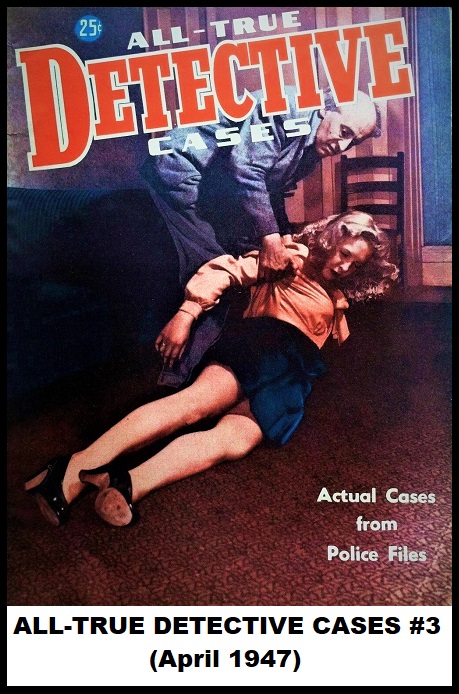
ALL-TRUE DETECTIVE CASES #3
(April 1947)
The call for protectionist legislation by Schrag and his alliance of Canadian publishing interests was a daring declaration, one that was being championed by other Canadian manufacturers in a number of industries. The Canadian economy had been negatively affected by the influx of American goods since the end of WWII restrictions and by the end of the year, the government in Ottawa would respond.
Meanwhile, Export altered their focus (or lost their contract with Pemberton) and went from publishing for the United Kingdom market to publishing for the domestic readership. At least one magazine was published during this early phase, another true crime magazine entitled ALL TRUE DETECTIVE CASES #3 (April 1947), essentially a continuation of the format (and possibly the numbering) used in their previous crime magazines.
A meeting of Canada, the United States and twenty-one other nations met in Geneva, Switzerland in October 1947, and came to a complex agreement on tariffs and other measures meant to shore up the ailing post-war economies.
Great Britain had already taken steps by banning the importation of certain American products. As with Canada, the UK was suffering an imbalance in trade that affected the value of the pound and threatened the stability of their economy. The result would be a lack of popular items such as tobacco and American-made automobiles, but it was felt the risk was necessary. Canada faced a similar devaluation of their dollar and made a similar choice.
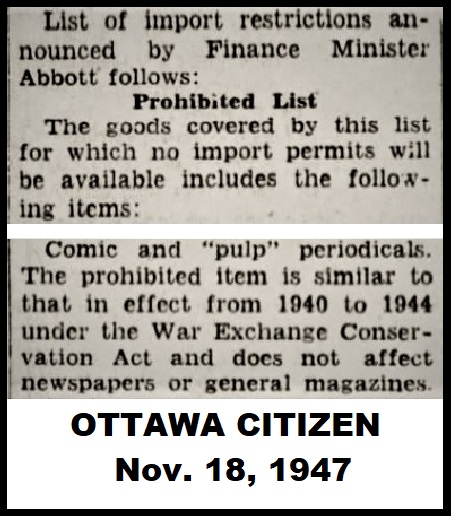
OTTAWA CITIZEN
Nov. 18, 1947
On November 18, 1947, Canadian Finance Minister David C. Abbott made the announcement of the resulting tariffs, restrictions and outright bans of American imports to be enacted. The long list of products and items affected included the sort of publications that Schrag and the Canadian Independent Publishers’ Assocation had called for earlier in the year.
“Lack of any announcement as to the duration of the import ban on comic books and pulp magazines makes it uncertain whether they will be printed in Canada from American plates, according to J.L. Ryder, manager of a distributing company.”
“There will be a shortage of this type of publication as there was during the war, he stated, but whether this would be relieved by printing comics and pulps in Canada will not be known until publishers get some idea of the length of time the import ban will be in effect.” [“New Autos to Cost More Ban Import of U.S. Cars,” TORONTO DAILY STAR, Nov. 18, 1947.]
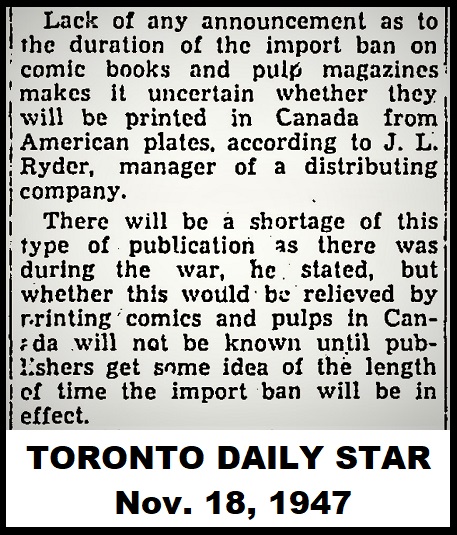
TORONTO DAILY STAR
Nov. 18, 1947
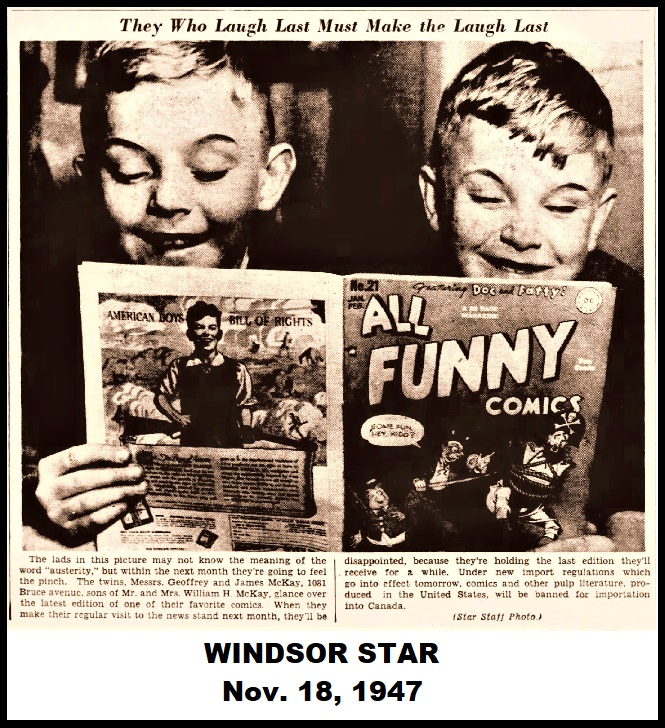
WINDSOR STAR
Nov. 18, 1947
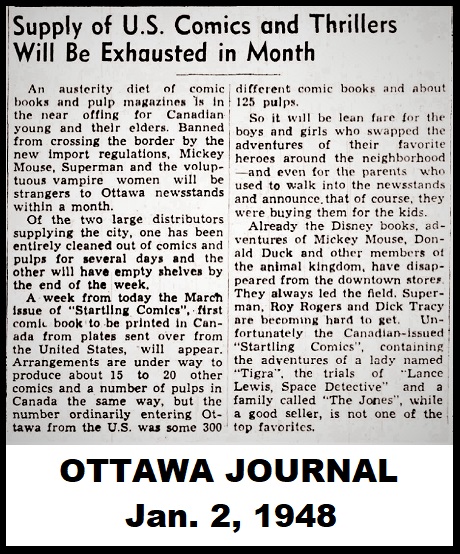
OTTAWA JOURNAL
Jan. 2, 1948
“An austerity diet of comic and pulp magazines is in the near offing for Canadian young and their elders. Banned from crossing the border by the new import regulations, Mickey Mouse, Superman and the voluptuous vampire women will be strangers to Ottawa newsstands within the month.”
“A week from today the March issue of ‘Startling Comics,’ first comic book to be printed in Canada from plates sent over from the United States, will appear. Arrangements are under way to produce about 15 to 20 other comics and a number of pulps in Canada the same way, but the number ordinarily entering Ottawa from the U.S. was some 300 different comic book and about 125 pulps.” [“Supply of U.S. Comics and Thrillers Will Be Exhausted in Month,” OTTAWA JOURNAL, Jan. 2, 1948.]
The immediate impact of these new protectionist policies on Export Publishing was the expansion of their paperback line. They produced two series under the News Stand Library imprint, one for the Canadian market (165 titles) and a second one for the American (28 titles). This would be Export Publishing’s first foray south of the border into the United States.
The Canadian series first appeared with mid-1948 copyrights and covered a range of genres, primarily Westerns, science fiction, detective and steamy potboilers. Many times women, provocatively posed and in various stages of déshabillé, were featured prominently on the covers, suggesting more than the text usually delivered.
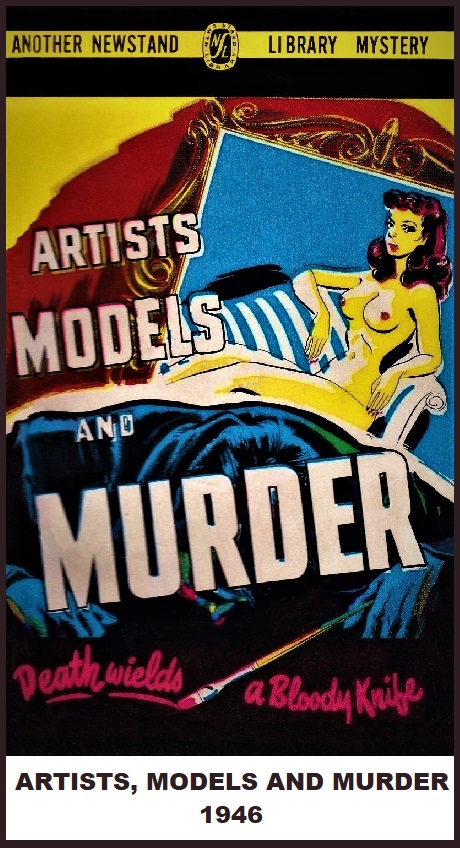
ARTISTS, MODELS AND MURDER
May 1948
Once again, Tedd Steele figured significantly in the content coming from the News Stand Library. Under his own name and various pseudonyms, he authored at least four of the books, the first being ARTISTS, MODELS AND MURDER, a May 1948, reprinting of a 1946 mystery novel he had written.
“It’s been two months since Steve Black left New York to set up shop in Metropolis and he’s still awaiting his first client. What the particular dick thought was a smart move–‘there’s only three other detective agencies here’–has brought only bitterness. ‘There’s not enough crime in this burg.’ This goes some way in explaining why it is that Steve allows himself to be hired by broken-hearted Webster Reynolds.”
“The cover copy errs in mentioning a Manhattan murder before going on to claim: ‘Artists, models and gunfire are bound up in a swift-moving train of events that thrust Steve into a multitude of situations both hair raising and hilarious.” [Busby, Brian, THE DUSTY BOOKCASE, “A Comic Book Artist’s Absurd Murder Mystery,” (2013)]
The other credited Steele books for News Stand Library–PAGAN (Aug. 1949, as ‘Jack Romaine”), TORCH OF VIOLENCE (Oct. 1949, as “Gerald Laing”) and the Western tale, TRAIL OF VENGEANCE (Sept. 1950, under his own name). It is quite possible that Steele also provided the cover artwork for these books and others in the series.
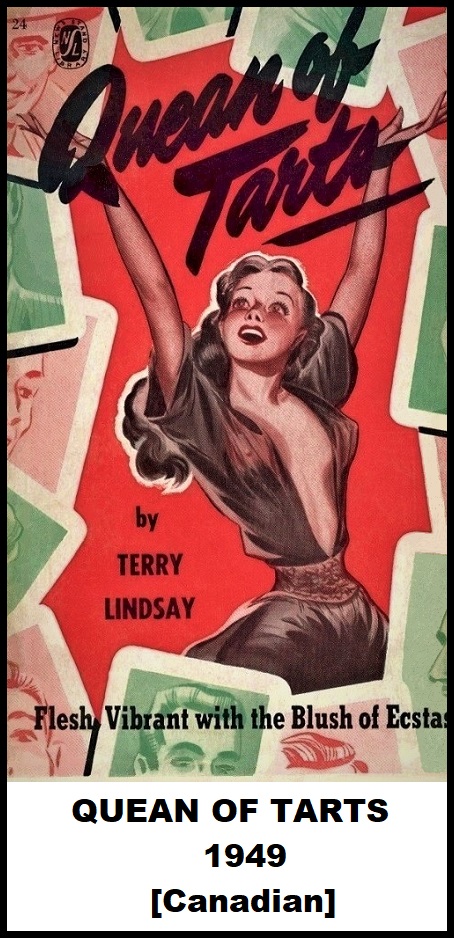
QUEAN OF TARTS
1949
[Canadian]
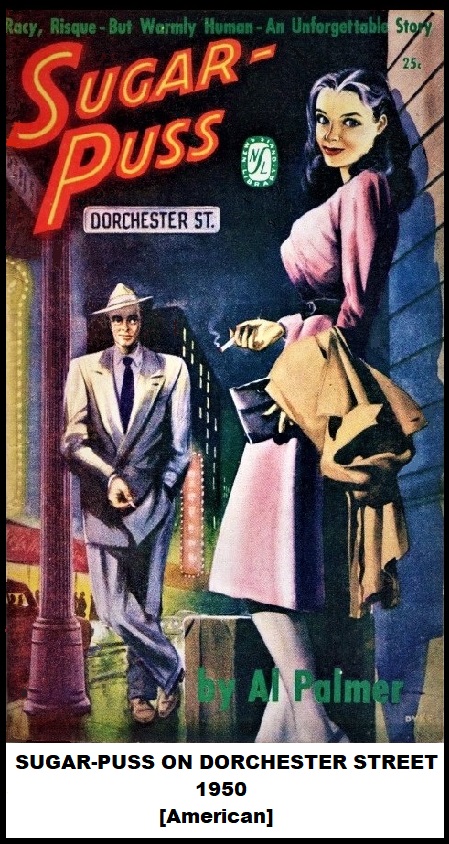
SUGAR-PUSS ON DORCHESTER STREET
1950
[American]
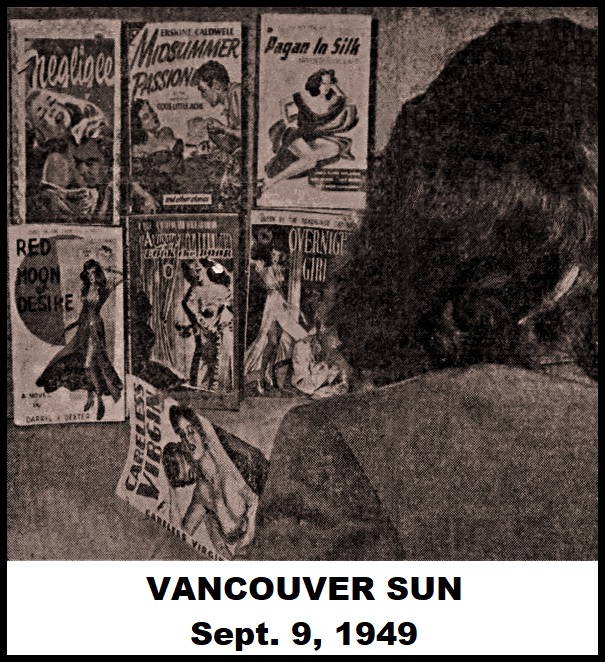
VANCOUVER SUN
Sept. 9, 1949
[News Stand Library paperbacks among others]
For the most part, these reprints were near duplicates of the American originals. Same interiors, same cover and logos. In a few cases, though, a different title appeared along with a different cover.
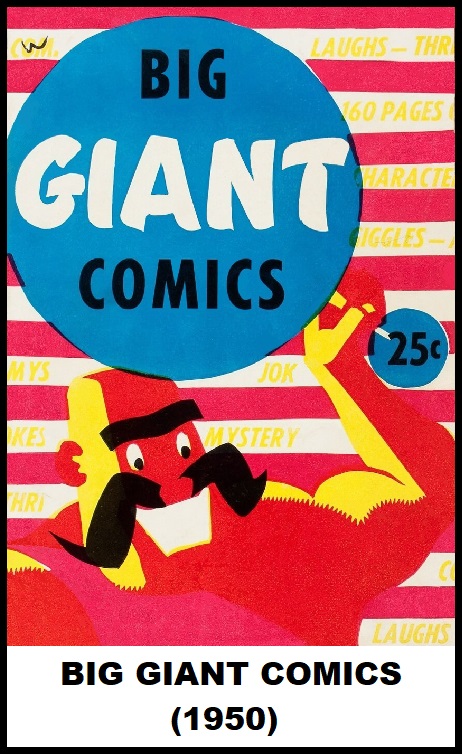
BIG GIANT COMICS
(1950)
[Fawcett reprints]
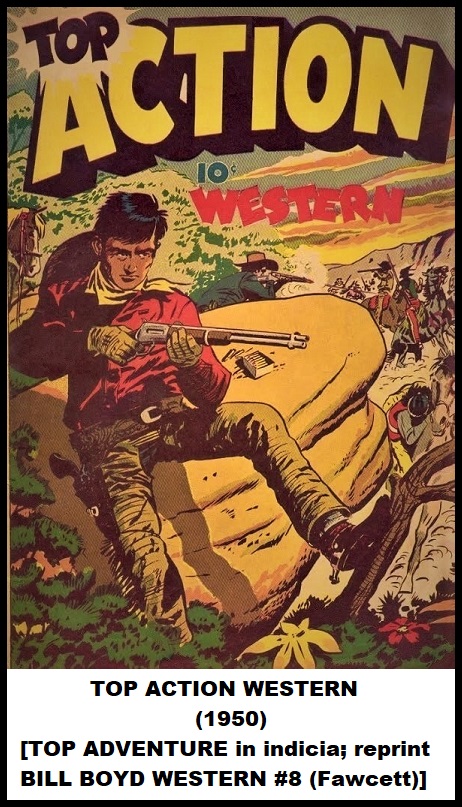
TOP ACTION WESTERN
(1950)
[TOP ADVENTURE in indicia; reprint of BILL BOYD WESTERN #8 (Fawcett)]
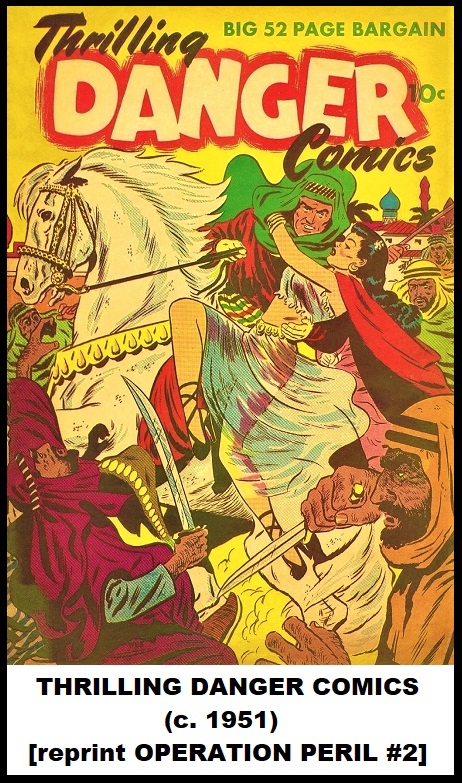
THRILLING DANGER COMICS (c. 1951)
[reprint OPERATION PERIL #2 (ACG)]
The first of their original material comics appeared to be HOCKEY COMICS, which didn’t carry a date anywhere, but a clue to its approximate appearance can be found in the advertisement on its back cover.
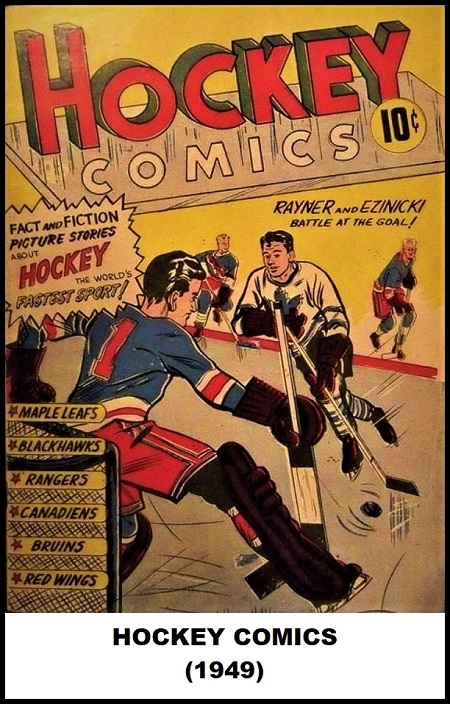
HOCKEY COMICS
(c. 1949)
[from the collection of Stephen Lipson]
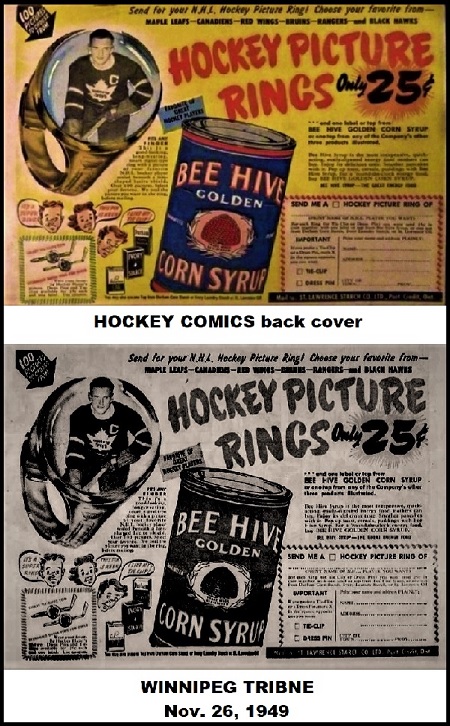
HOCKEY COMICS back cover,
WINNIPEG TRIBUNE
Nov. 26, 1949
The hockey-themed comic must have had some level of success, as in March 1950, there are several indications that Export Publishing was planning to grow that part of their business.
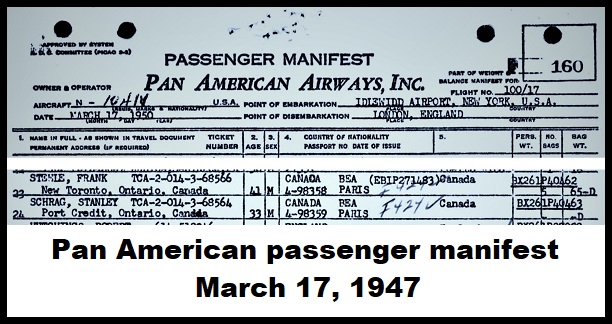
Pan American passenger manifest
March 17, 1947
On March 17, Stanley Schrag and Frank Steele took an airplane flight from New York City (where they also had an office) to London, England. From there, their itinerary took them to Paris, France. Were they thinking of staying true to their original business and planning on exporting their new comic book line to the UK and Europe?
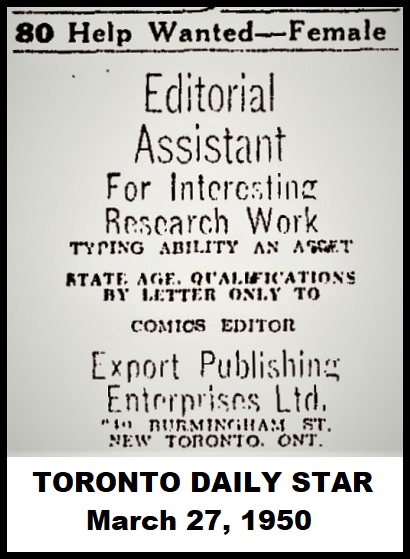
TORONTO DAILY STAR
March 27, 1947
Then, on March 27, Export ran a “Help Wanted” newspaper ad seeking an “Editorial Assistant for Interesting Research Work” and asking them to reply to the “Comics Editor.” An expansion of the comics business seemed to be in the works.
If Export was indeed seeking to expand its publication of comics, it picked a difficult time to do so.
In December 1949, the Canadian Parliament passed a law banning the sale of “crime” comic books. This reaction paralleled similar actions being taken in the US by local jurisdictions concerned about the effects comics were having on children. The nationwide scale of the Canadian ban would have a devastating affect on their domestic comic publishers and those publishers made their concerns known.
“Canadian comic book publishers today asked the federal government t reduce the severity of a law passed last year by parliament banning crime comic books.”
“[The Comic Magazine Industry Association of Canada] contended that it was unfair to adult readers to ban crime comic books from sale altogether. The ban should have applied only to children.”
“The act passed last session provided that any person could bring action against a distributor or producer of crime comic books. The association thought this was too broad, since even the prosecution, without a conviction, could be harmful to a magazine.”
“The act…provides that it is not necessary for the prosecution to prove that the bookseller knew the magazines he sold were crime comics.”
“‘We suggest that it would be more realistic and more consistent with the principles of British justice, that no such bookseller or distributor should be fixed with the presumption of knowledge of the contents of a comic magazine,’ the brief.”
“The brief emphasized the importance of the comic magazine industry to Canada’s economy and reported that the dollar value of exports of the magazines to the United States was $172,177–more than 20 per cent of the value of exports of all newspapers and magazines exported to the U.S. last year.” [“Comic Book Producers Ask Easing of ‘Ban’ Law,” TORONTO GLOBE AND MAIL,. Feb. 22, 1950.]
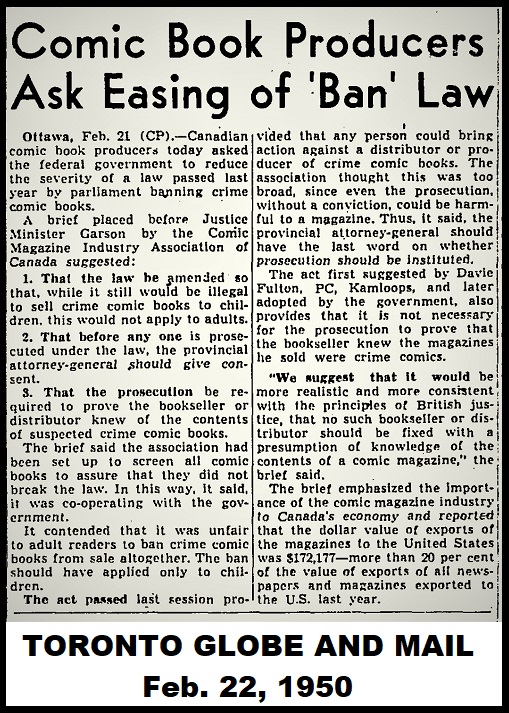
TORONTO GLOBE AND MAIL
Feb. 22, 1950
Canadian publishers were further agitated by a governmental decision announced on September 20, 1950.
“Finance Minister Abbott Tuesday declined to meet a request of the Canadian comic-book industry that United States comic books be banned for all time. Instead, he said, he would consider opening the import doors still wider with the ‘quite near future.'”
“The request was contained in a 1,000-word brief presented to Mr. Abbott by a four-man delegation on behalf of the Comic Magazine Industry Association of Canada [CMIAC].”
“Noting the import controls will be relaxed October 1, the delegation called for ‘absolute import restrictions on comic magazines for these reasons:'”
“‘1. ‘A prosperous infant industry is in danger of complete extinction by the removal or even the contemplated qualification of import restrictions.'”
“‘2. Imports of U.S. comic books would clear the way for the shipment of a ‘great many potentially obnoxious comic magazines.'” [“Abbott Letting in More U.S. Comic Books Soon,” OTTAWA JOURNAL, Sept. 20, 1950.]
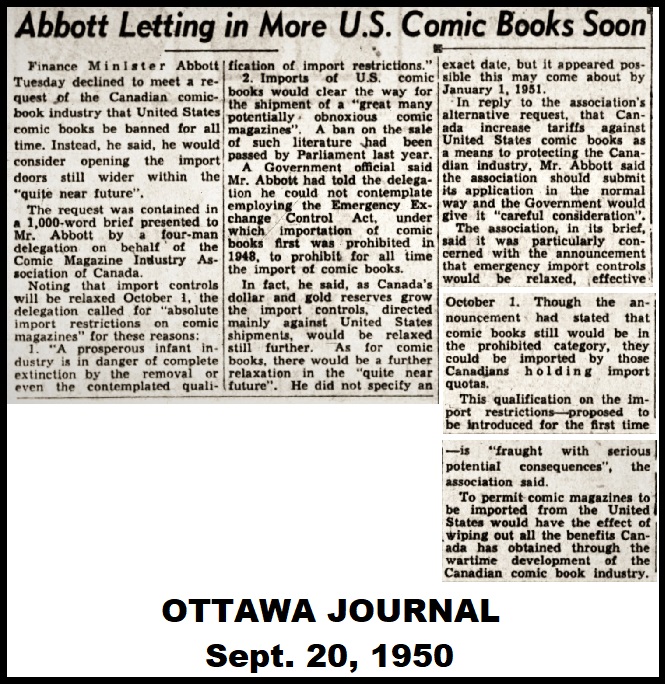
OTTAWA JOURNAL
Sept. 20, 1950
While Abbott did not flat-out refuse the CMIAC request, it was apparent that the import ban was due to end soon.
The surprising size of the export of Canadian comics to the US explains why Export Publishing wanted a part of that business, even with the uncertainty of what the future may hold for the industry. Export was undeterred as it put together its staff to produce original material.
Along with the expanding comic book line, Export conceived a new magazine aimed at youngsters. Titled, JUNIOR WEEKLY, it was touted as “an exciting, thrilling interesting, different magazine–a WEEKLY Magazine that every Boy and Girl will want to get every week.” [JUNIOR WEEKLY advertisement on back of TOP ACTION WESTERN]
The ad was signed by “Captain Happy,” a pipe-smoking, handsome, young sailor. Presumably, this dashing swab was the spokesman for the magazine, but his name was strikingly similar to the titular star of the company’s comic book, CAPTAIN HOBBY COMICS.
“Captain Hobby” was also a sailor, but he had about 40 years and 75 pounds on the upstart appearing in JUNIOR WEEKLY. This old sea dog had apparently retired and in his one story, he related a tale to a couple of children about a treasure he had rescued from a pirate crew. The younger “Captain Hobby” in the story looked suspiciously like “Captain Happy.”
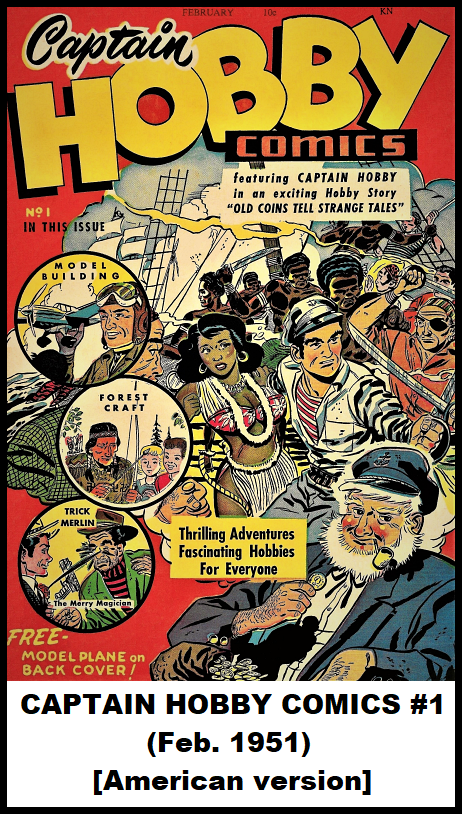
CAPTAIN HOBBY COMICS #1 (Feb. 1951)
[American version]
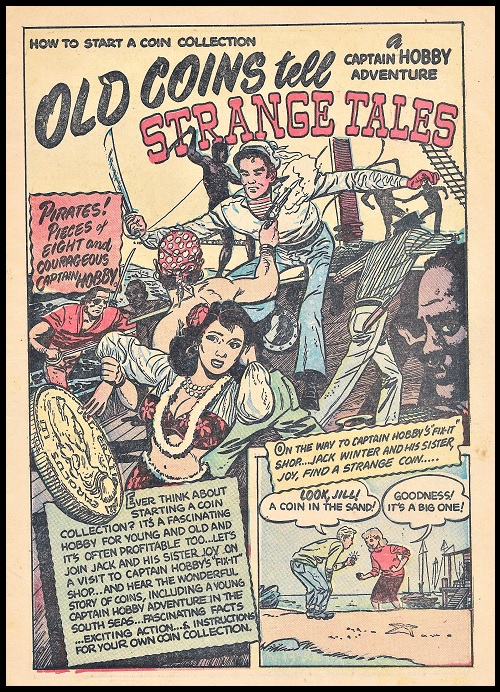
Pg. 1
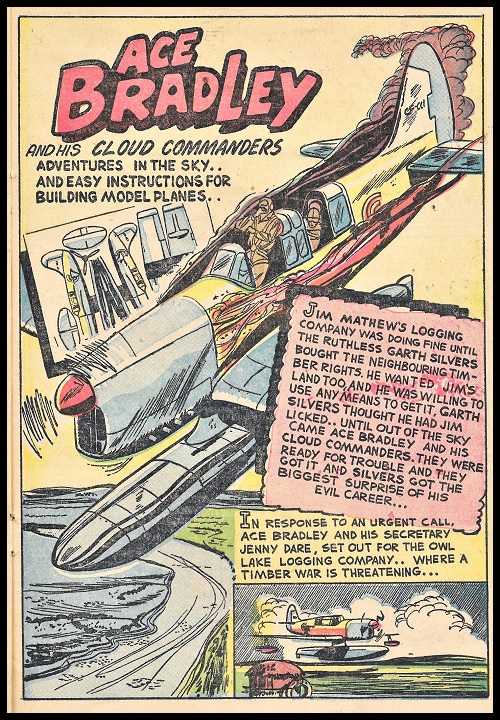
Pg. 2
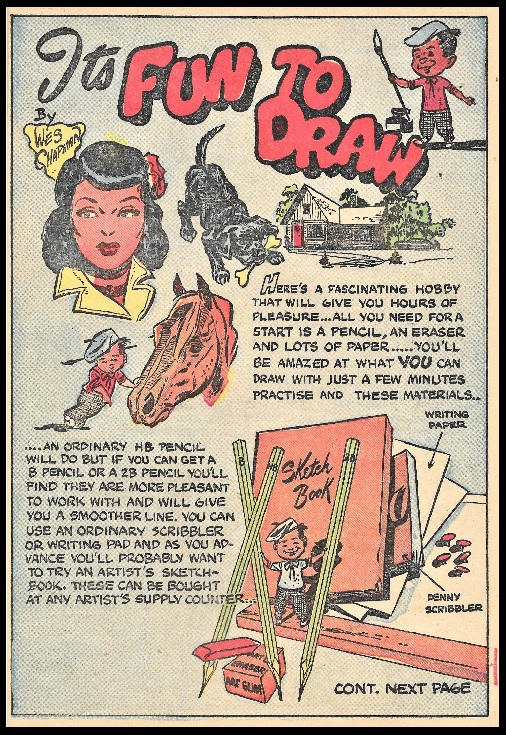
Pg. 3
The artwork on most, if not all, the features in CAPTAIN HOBBY, seem to be the work of one person, but only one of the features was signed. Wes Chapman was the signer and he was apparently Export’s main artist.
Chapman was born on April 17, 1929, in Toronto, making him a bit too young to have worked in the “Canadian White” comics era during WWII. He is credited as the artist on the“Rex Tyler” feature that ran in RED SEAL COMICS #22 (Dec. 1947). This was one of the “hybrid” American/Canadian comics that contained unused artwork from the Harry ‘A’ Chesler shop and supplemented with original Canadian art.
Chapman not only supplied all the artwork for CAPTAIN HOBBY, but also the covers to TOP ACTION WESTERN, THRILLING DANGER and several of their paperback line. He was also listed in JUNIOR WEEKLY as an Assistant Artist.
Besides the one signed page in CAPTAIN HOBBY, the “Drawatoon” feature appearing on the inside covers of the comic is credited to “Harry and Wes,” likely a team-up of Chapman and editor Harry M. Steele. Occasionally, he would sneak his name “Wes” into the design of the art, as he did on the covers of THRILLING DANGER and the next Export Publishing original comic, SCIENCE COMICS #1.

SCIENCE COMICS #1
(March 1951)
[American version]
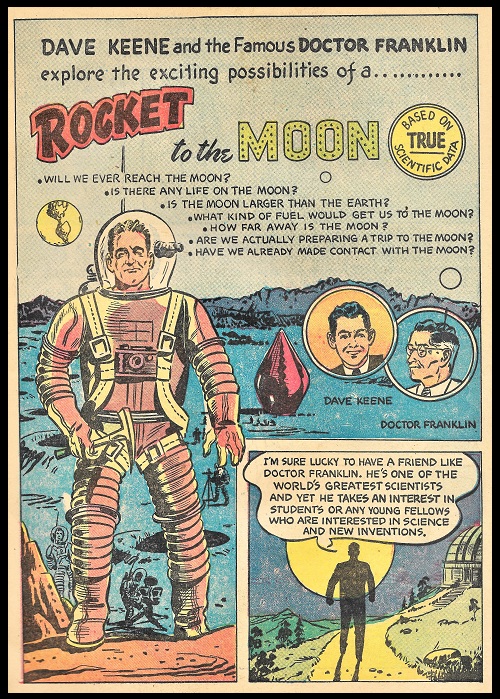
Pg. 1
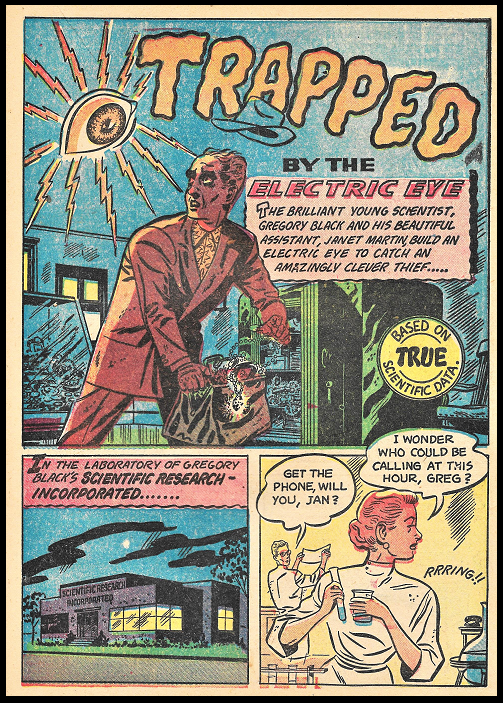
Pg. 2
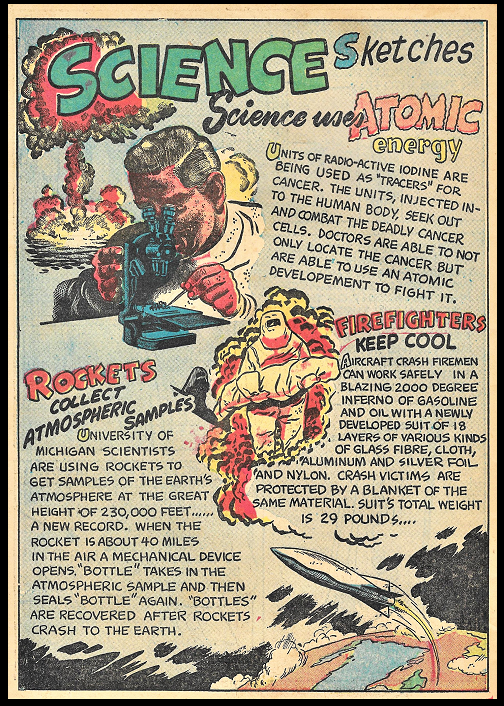
Pg. 3
Curiously, SCIENCE COMICS #1 existed in two versions. One was undated and no price on its cover. The second version was dated “March” and displayed a “ten cents” price. Presumably, the undated, unpriced version was sold only in Canada and the second version was sold in the US. The indicia of the American version carries the date of “March 1951,” and noted that it was distributed in the US by Kable News Company.
Kable News was a large American distributor and printer that had been in business since 1898. Based in Mount Morris, Illinois, west of Chicago, the company had long been a major force in comic book distribution and its connection to Export Publishing may indicate that it had a financial interest in the Canadian publisher. It is also worth mentioning that Stanley Schrag had spent time in the Chicago area previously and would again in the future.
Although only one version of CAPTAIN HOBBY has surfaced to this point and it carries both the date and the price as the American version of SCIENCE COMICS #1, the possibility exists that it may also have been published in two versions.
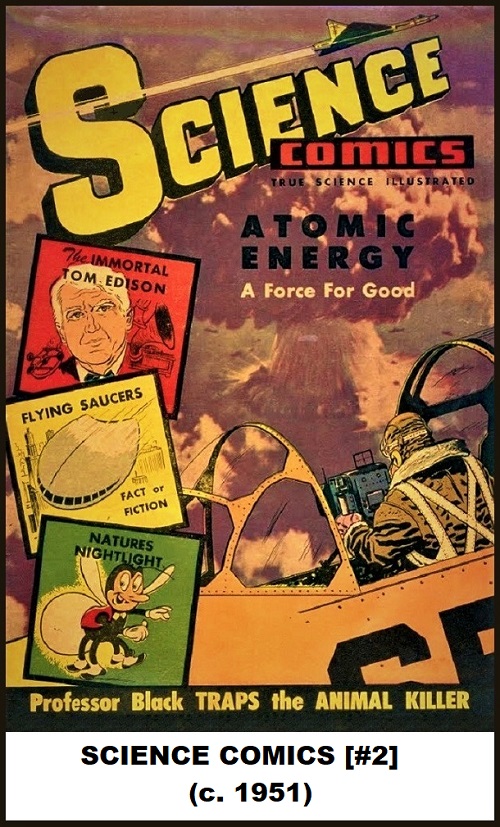
SCIENCE COMICS [#2]
(c. 1951)
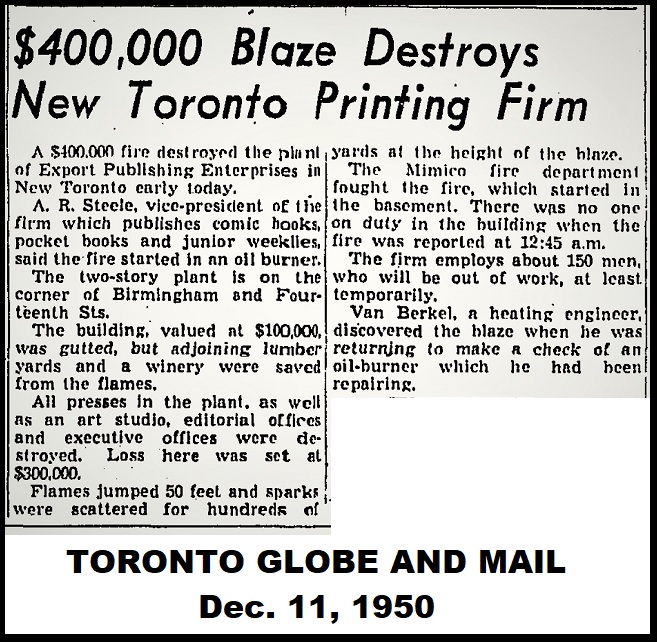
TORONTO GLOBE AND MAIL
Dec. 11, 1950
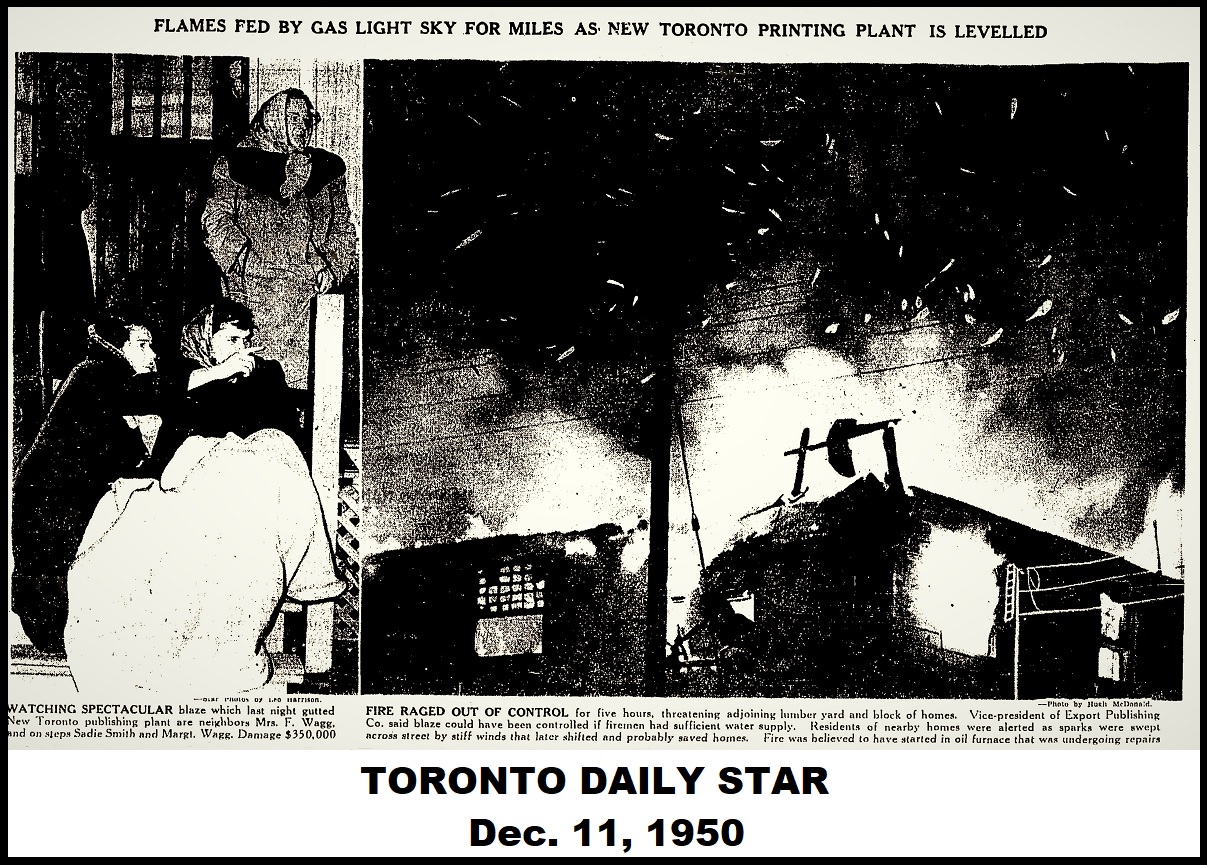
TORONTO DAILY STAR
Dec. 11, 1950
“An investigation into the fire which ripped through the Export Publishing Company’s plan[t] Sunday night was immediately launched and investigators swarmed over the fire-blackened premises Monday morning.”
“Fire Chief Harold Walton of New Toronto said half the building was in flames by the time firemen reached the scene. The fire department attempted to save the rear half of the building but huge flames fed by an oil furnace and leaking gas pipes blazed uncontrollably.”
“One of the hazards firemen had to face Monday morning was the presence of children who scoured the premises looking for comic books. Piles of burned and half-burned books filled the plant.”
“Fire Chief Harold Walton said their first knowledge of the blaze was when a stranger walked in.”
“Nonchalantly walking into the New Toronto Fire Hall a stranger said, ‘Hey, bud, there is a big fire up the street.’ and disappeared.”
“All presses, an art studio, executive offices and editorial offices were destroyed. A new $55,000 press, being installed, was also destroyed.”
“It is believed the fire started in an oil furnace which was being repaired. C. Van Berkel said he had been working on the furnace and went to his shop for tools. When he returned he opened the door and found the building in flames.” [“Order Investigation in Export Pub. Fire,” THE ADVERTISER, Dec. 15, 1950.]
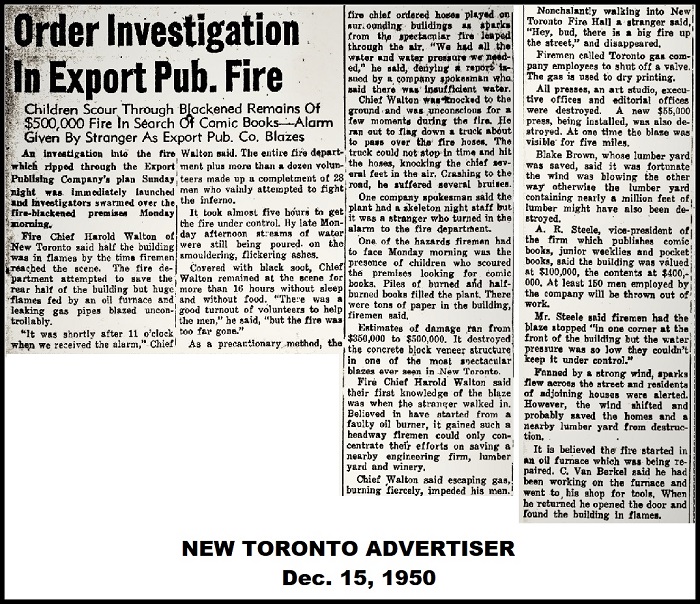
NEW TORONTO ADVERTISER
Dec. 15, 1950
Strangely, it was not the repairman Van Berkel who reported the fire, but “a stranger” who then mysteriously disappeared. If that wasn’t reason enough to suspect arson, perhaps this short legal notice that appeared two days after the fire would have been.
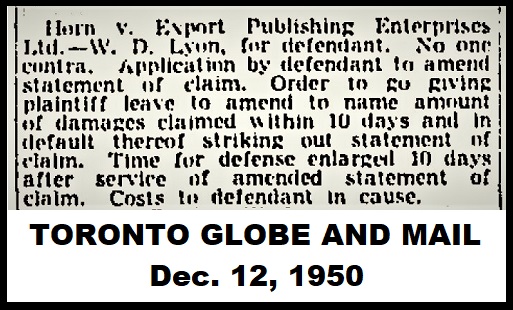
TORONTO GLOBE AND MAIL
Dec. 12, 1950
To clarify the legalese in this notice, the author consulted Wayne Smith, a noted corporate lawyer and this was his response. Please note that Smith is an American attorney and there may be some differences in Canadian law.
“Apparently, the plaintiff Horn had filed a lawsuit against Export claiming unspecified damages and Export did not show up to defend and was defaulted. Horn then asked the court for permission to amend the complaint to state the amount of damages sought.In American law, there is a general rule that if an amount of damages is not requested the complaint, a default by the defendant in responding to the complaint does not result in a judgment for damages, only liability.” [text message from Wayne Smith to the author, Oct. 24, 2020.]
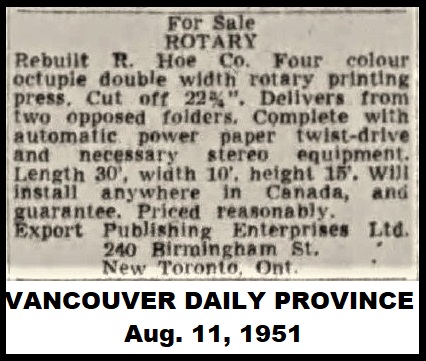
VANCOUVER DAILY PROVINCE
Aug. 11, 1951
One other factor that made the timing of the Export Publishing fire a bit too coincidental was that as of December 31, 1950, just a couple of weeks later, the ban against American comic books entering Canada was to end. If Export was having money problems, as indicated by the lawsuit, then knowing that an onslaught of competing product was coming from south of the border would probably have been more than it could bear. The fire conveniently allowed Export to avoid that fate.
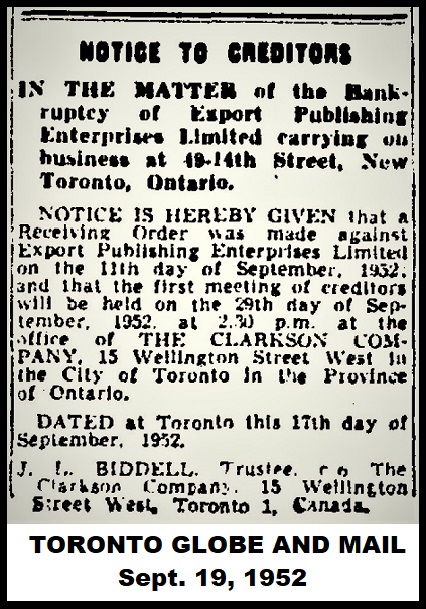
TORONTO GLOBE AND MAIL
Sept. 19, 1952
The fact that Schrag and company did not even attempt to resurrect the company may show that it would not have survived much longer in any case. The resulting bankruptcy indicated that Schrag was in over his head; that the new press purchase and expansion of the comic book line was a bad business decision.
Arson was apparently never proven, so Export Publishing went into bankruptcy. Over the next two years, their damaged building was auctioned off, they defaulted on their mortgage, salvageable printing presses were sold off and creditors’ claims against the company were settled by the courts.
After the demise of Export Publishing, the principles all went their separate ways.
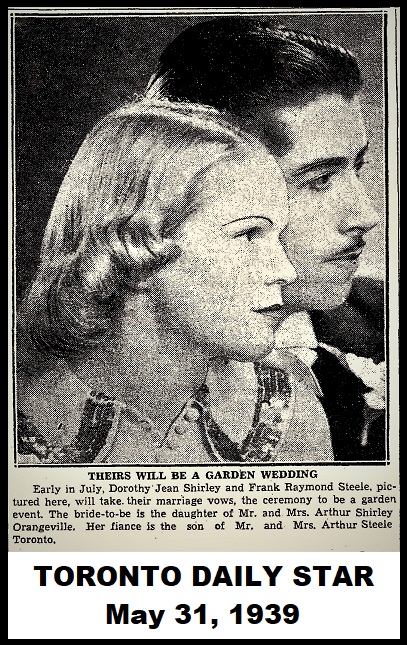
TORONTO DAILY STAR
May 31, 1939
Harry Maurice Steele, who had been a writer with Export, got a position with Maclean-Hunter, the large Canadian publisher of MACLEAN’S magazine, before eventually settling into a more mundane job as a credit manager. He died on Nov. 3, 1986.
While the immediate fate of older brother, Frank Raymond Steele, Export’s vice-president, is not clear, he was repeatedly noted in coming years as being a “salesman” in various sources. He passed away in a Toronto hospital on June 20, 1991. His obituary dutifully listed his many siblings and made a point of mentioning that he was a “lifetime friend of Stanley Schrag.”
Theodore Arthur “Tedd” Steele, both artist and writer for Export, made the logical transition into advertising. He enjoyed a long career in that field and as a freelance illustrator before branching out as the inventor of a weight-loss program.
“When the Tedd Steele family talks about the high cost of food, they are referring to calories, not cash.”
“In their North Toronto household, breakfast of dry toast, jam and tea costs 140 calorie-dollars; lunch of a hard boiled egg, lettuce and tomato is about 150; and dinner goes for around 500. Snacks add another 200 calorie-dollars.”
“The unique way of dieting started a couple of years ago when Gloria began another new diet for the umpteenth time. She had previously tried every popular diet going, plus diet aids and prepared, commercial diet foods.”
“‘I told Gloria if she had to pay cash for her foods, she would be very careful about what she ate,’ said Steele. ‘Then, all of a sudden I got the idea if a dieter had to pay cash for everything he ate, he would have no trouble keeping track.'”
“Steele is a freelance illustrator working from his home and quickly began a project converting calories to dollars. He made up a set of paper currency to equal $1,000 worth of calories in denominations of 5, 10, 20, 50 and 100.”
“Each time Gloria ate something she was told to check its caloric value and count out the money and place it aside. When she ran out of money, she had to stop eating.” [Cornell, Bonnie, “Man Creates Calorie ‘Money’ to Help Wife Lose Weight,” TORONTO DAILY STAR, Aug. 26, 1971.]
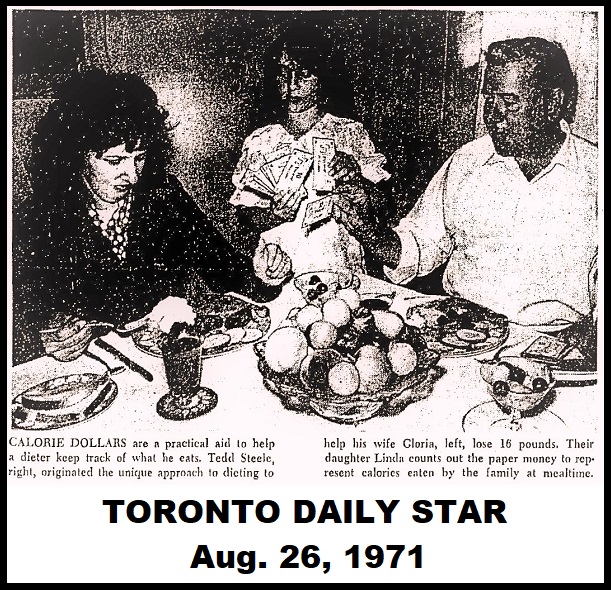
TORONTO DAILY STAR
Aug. 26, 1971
Beginning in Feb. 1971, Steele began marketing his diet plan, which consisted of diet tips, a booklet and a plastic wallet filled with calorie-dollars, for $1.98 in real money. He died on June 16, 1994, in Toronto.
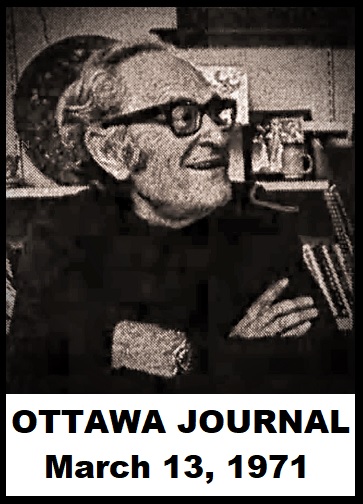
OTTAWA JOURNAL
March 13, 1971
Martin Kastner stayed in printing and publishing. He founded Markay, “a company that printed comic books,” according to his obituary. Later, that company evolved into a video and marketing firm run by his daughter, Kathy.
Kastner’s wife Rose was both his partner in life and work. She was an editor and a writer and teamed with Martin on his later translations of the plays of Bertolt Brecht into English. Most of the Kastner children went into acting, with several of them becoming stars on Canadian television programs of the 1960s and 1970s. In 1966, Martin gave up publishing and dedicated the rest of his life to creating bronze sculptures of characters from Brecht plays. He died in Toronto of a heart ailment on Jan. 7, 1976.
The talented artist Arthur Wellesley “Wes” Chapman went straight into advertising after Export, becoming one of the best and fastest illustrators in Toronto. Even though he was born in the that city, Chapman was a cowboy at heart. He worked on several trail rides, had a Western-themed wedding on a horse ranch, became a traveling Country-Western singer/comedian and eventually, a noted painter of Western scenes. He fulfilled his cowboy dreams when he moved to Scottsdale, Arizona in the late 1970s and spent the rest of his life depicting landscapes and capturing images of cowboy life. Chapman passed on March 8, 1995, in Scottsdale, Arizona.
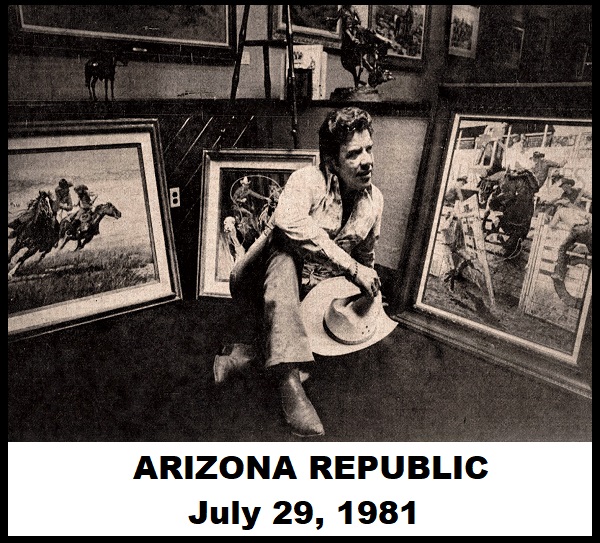
ARIZONA REPUBLIC
July 29, 1981
After the bankruptcy and legal entanglements were settled, Stanley Roland Schrag moved from Canada to Rockford, Illinois. Rockford was a familiar area to Schrag, right between Chicago and Mount Morris where Kable News had its headquarters. He found a job at Bliss Printing as a salesman, but he did not stay long, as he soon was back as a publisher.
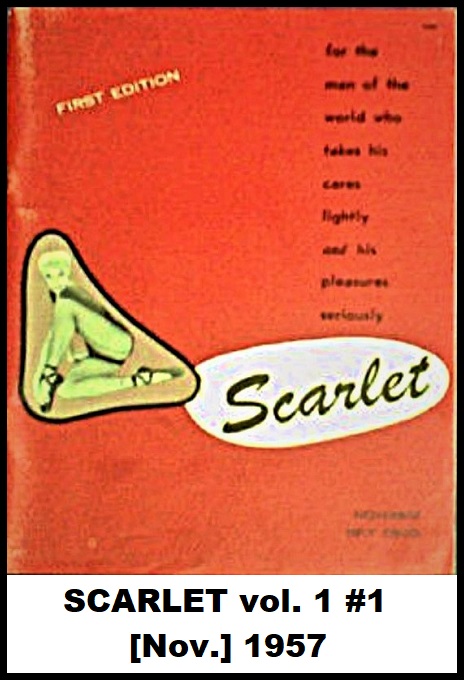
SCARLET vol. 1 #1
[Nov.} 1957
“The December [Philadelphia] grand jury has indicted six Illinois men as fugitives on charges of conspiring to distribute and distributing obscene literature.”
“All are connected with the magazine ‘Scarlet,’ published in Rockford, Ill. The periodical has been banned by the district attorney from the Philadelphia newsstands.”
“Those indicted are Stanley R. Schrag, Rockford, owner of the magazine; its editor, Carlyle Stevens, three editorial assistants, Harry Morris, Frank Raymond and J. M. Thorpe, of Chicago, and Raymond Kirk, Chicago, identified as its national distributor.” [“Crack Down on ‘Scarlet’ Magazine,” MT. VERNON REGISTER-NEWS, Dec. 12, 1957.]
Schrag had surrounded himself with an interesting group at Scarlet Publishing. Carlyle Stevens was a Canadian-born radio host whose career peaked in the 1930s and 1940s. Raymond Kirk specialized in distributing “smut,” ADAM magazine among them. A few years after this dust-up, he would once again be indicted in Philadelphia for the exact same crime.
“Harry Morris” and “Frank Raymond” were likely pseudonyms for Harry Steele and his brother, Frank. It was not much of a ruse, as they simply dropped their last name and used their first and middle. Whether they relocated to Rockford to assist with the editing or remained in Canada and did it from afar, is unknown.
The contents of SCARLET, which featured the usual photo spreads of strippers and models such as Dianne Webber, were no more scandalous than most of the other PLAYBOY imitators that proliferated in the 1950s and it was just one of many that got caught up in the national crusade to rid the newsstands of such publications. Likely not much came of the indictment other than Schrag promising to stop SCARLET’s publication, as he soon had moved on to yet another publishing venture. He returned to paperback publishing and in doing so, he revived the name Newsstand Library.
The content of these paperbacks was a bit more lurid than its 1940s predecessor. They generally carried painted covers by the very talented Robert Bonfils, but that did not stop them gaining Schrag another court date.
“The publisher of a 127 page paper back [sic] book was found guilty yesterday of publishing an obscene book.”
“Judge Eiger said he spent two hours reading the book involved in yesterday’s case and ‘found very few pages which did not contain either an obscene word, act, expression, or circumstance.’”
“‘It is replete with acts of perversion, incest, and sexual orgies. Its total impact is an appeal to a prurient, lewd, and lascivious mind. It definitely violates community standards and is outside the area of the federal and state Constitutional provisions for protection of free speech and press,’ Judge Eiger said.”
“Austin Rigney, assistant corporation counsel, said the city has an agreement with Stanley Schrag, president of the publishing company, under which the company will discontinue a line of 35 books the city [Chicago] believes to be obscene. Rigney said the company now is out of the ‘sensational’ paper back business and publishes only comic and joke books.” [“Book Obscene, Judge Decides; Company Fined,” CHICAGO TRIBUNE, Nov. 24, 1960.]
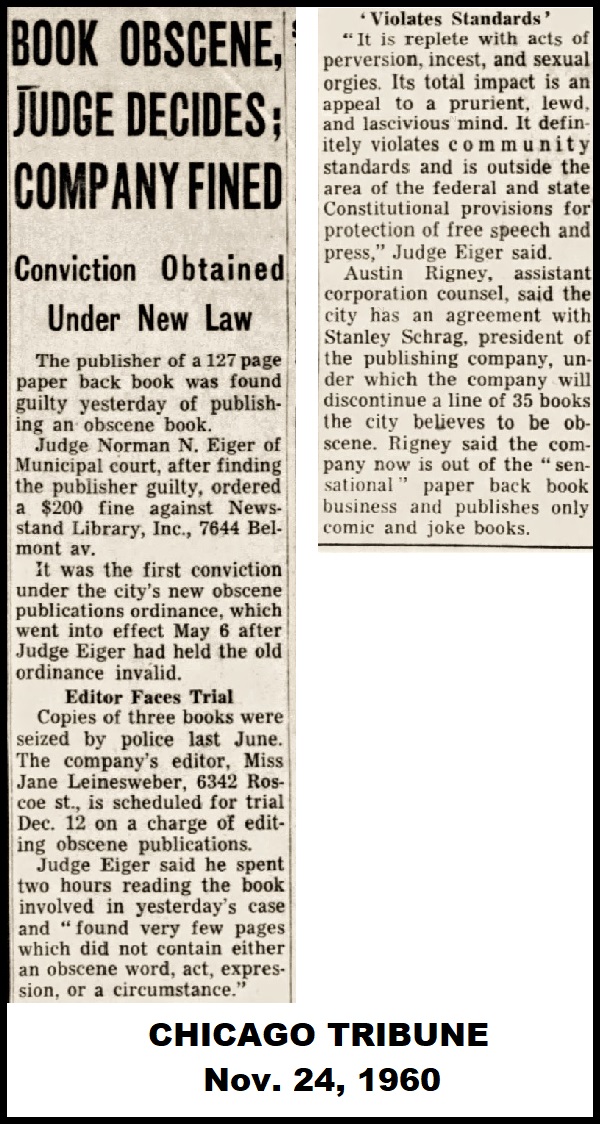
CHICAGO TRIBUNE
Nov. 24, 1960
Schrag seemed unable to avoid trouble. In June 1966, he was in Pompano Beach, Florida and was named as a defendant in a federal court case brought by mystery writer Richard S. Prather, who charged that Schrag and his co-defendants had lifted material from three of his books and used it in a book titled HOTEL HUSTER that they published.
In May 1968, Schrag and the other defendants lost the copyright infringement case and were ordered to pay $17,571 in damages to Prather and destroy all remaining copies of HOTEL HUSTLER.
The peripatetic Stanley Schrag moved on once again and on April 7, 1993, he died in Atlanta, Georgia.
